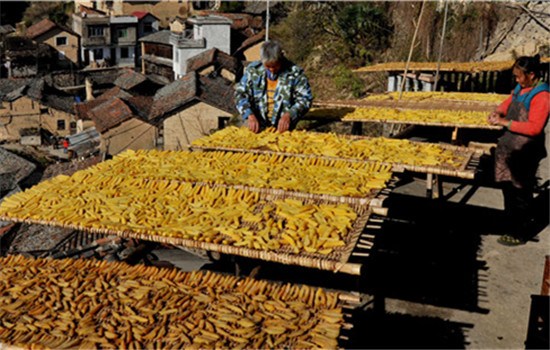
Villagers dry newly harvested sweet potatoes under the sun. (WANG KAIHAO/CHINA DAILY)
"We would like the money to become a tool to mobilize more social effort," says Li. "It is a move to seek the greatest common dividend for all concerned."
Though the project emphasizes the future functions of the houses, standards of maintaining cultural heritage sites should still be followed, says Lu Yuanzheng, deputy director of the Zhejiang Provincial Institute of Ancient Architectural Design and Research, which is participating in the restoration.
"It (the project) is like repairing the Forbidden City in Beijing," he says. "When things can be fixed, they will not be replaced.
"And, we cannot combine different architectural styles in the restoration, so we rely on local artisans. That is a good chance to revitalize traditional craftsmanship."
But, he admits that challenges remain. For instance, he says, if a house is co-owned by different families, the owners often have different views on how the house should be revamped.
"That is why we need a system to work out how much money is needed for each restoration.
"A customized plan is needed for each case, but certain technical standards have to be set for general guidance."
Songyang is currently listed by the Ministry of Housing and Urban-Rural Development and the State Administration of Cultural Heritage as the country's only trial region for the revitalization of traditional villages.
Separately, creative thinking is being used in the renovation process.
In Youtian, for example, an abandoned cowshed, which used to be co-owned by 14 families, was taken over by the village committee after paying 3,500 yuan ($506) to each family. And it was turned into a countryside inn after restoration.
"If it runs well, more villagers will see benefits of restoration," says Ye. "And more houses will be saved."
According to Lei Chao, deputy head of the county government in Songyang, about 20 million yuan is now being allocated annually by the local government for the revitalization of traditional villages, and subsidies are also provided to villagers running home inns, at up to 120 yuan per square meter.
But restoring the houses is only one piece of the puzzle for some.
"It's easier to restore houses compared with rejuvenation of traditional lifestyles in the Chinese countryside," Lei says.
"The resumption of eco-friendly agriculture and traditional folk art cannot be absent."
An ideal rural community should include its original residents returning from cities and finding work opportunities at home, and urban folk looking for serenity, he adds.


















































